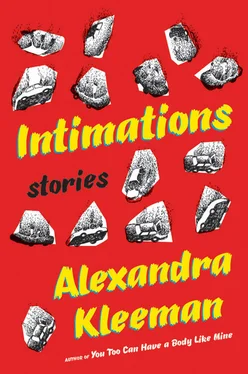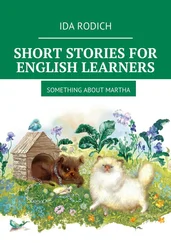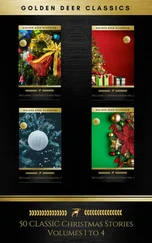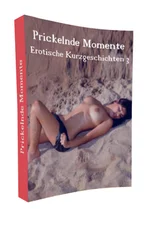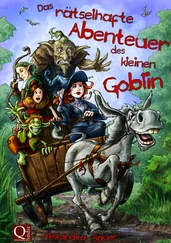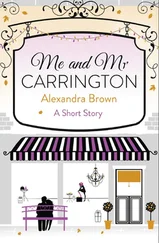My mother dons raincoat, gloves, galoshes, and an oversize hat. She opens the umbrella and steps outside, gingerly over the cobblestones, gingerly to the collection tank. The plastic frame is filled with droplets of water suspended in midair, shaped like downward momentum, but paused there. Paused. She takes the large glass jar from beneath her coat and fills it with sleeping rain. The cap again atop the jar.
We have learned that the weather cannot be kept outdoors and must be brought indoors, dragged indoors, before it brings itself indoors. We create the image of a house where the outside must ask to be let in, where it rings the bell and wonders what to do with its hands while it waits for someone to come to the door. Through such preemptive tactics we show it that, though it may cover the whole world, we cover the world inside our house.
When my mother comes back, she leaves the jar on the kitchen counter. The raindrops inside look sad or exhausted. They stir, but only slightly.
We maintain a constant temperature of 73 degrees within our house, counteracting temperature drops with baths and warm foods, counteracting rises in temperature with meals of ice and cold water.
We gather in photographs in triangular formations, the hands of the two larger on the shoulders of the smaller, as if we could become a single solid structure.
Nineteenth-century physicist Arthur Worthington photographed drops of milk at their moment of impact with a hard surface, providing irrefutable evidence of “the deeply lodged gimpishness of nature at her core.” While scientists had previously imagined the splash patterns of liquids to be regular, symmetrical, crystalline, the photographs taken within Worthington’s laboratory revealed ragged blooms that threw themselves up into the air with “indiscrimination worthy only of a pratfall.” They surged up upon impact, or seemed to reach outward with irregularly sized pseudopodia. With this material proof of their irregularity, naturally occurring phenomena entered the category of “trainable effects,” like “the squelching and spattering sounds that emerge from a mouth in the process of doing other than generating meaningful speech” that we silence with practice and much cloth.
The walls of our house are to its space as the rules are to a game. In between lie air, and everything allowed. We run circles from the kitchen through the den through the bedrooms through the kitchen.
Controlling the weather will be the first step past building descriptions that cannot hold it in. It could be the first step out of this house that we have lived so far into and through.
At dusk, we play a game of thought and guessing. This is recreation, which fills the spaces between moments of productive friction, moments in which we create. In the dusk, the space within takes on a color to which it is difficult to respond. We want to turn the lights on but it is too early, we want to keep them off but it grows too late. We want a space in which we could half do, do halfway, but we are forced to be one thing or another, except within the act of hoping.
Our family, like other collections, possesses a nested structure. My father has known the most and thus could know us better than we know ourselves: he could dream us and we would not know the difference. My mother has seen less and knows proportionately less, and I know the least possible. I could fold up into her, and her into him. We would live inside him like a house, one large white house with two tiny windows on the front. In this house we would have all the things we have now, but we would have no father.
The game is called Many Questions. It happens like this:
I’m thinking of an object, my father says.
Is it a refrigerator? asks my mother.
No, it is not, he replies.
Is it my kitten? I ask.
No, no, he answers.
Is it a stop sign? asks my mother.
It is not, he replies. Now, why in the world would I think of that?
THAT WHICH MEETS NO RESISTANCE
The first idea was to build a house free of weather. Mother says Father was sleepless for weeks, drawing plans for houses without doors, without windows, houses without pipes for outdoor water to enter, houses without any air inside at all.
The first idea was to build a house free of weather. But they discovered within the removal processes a secondary origin of weather. A house with nothing to resist — no rain, no wind — finds areas of resistance within, growing frustrated with its own stasis, shuddering and crumbling around its own stable shape. He formulated a rule: The shelter that meets no resistance shall resist itself.
It was many days ago that Father’s rule was proven accurate and, conversely, that our house proved itself to be a rule. I curled around my warmth as the morning opened itself up, peacefully, without even drops of dew or the movement of birds outdoors. A sharp whine began from within the walls and floor, making items of furniture whine too, like a bomb about to go off. The things on the walls fell off during this whining, and the things on the tables fell with the onset of a chugging, painful sound from machines somewhere within the house. Around us, two gulps softly and one spasm like an attempt to hurl something from the throat. I said that it seemed the house felt we were alien, but I was told that was unlikely. The machinery, built to withstand high winds and violent events, was simply buckling under the weight of very little: through induced outer turbulence we would regain the internal stillness that comforted our objects and our routines. The floor was on a tilt and I watched the round things roll away and out of the room, and the flat and square things slide more slowly toward a similar exit. In another room the refrigerator was on fire, burning up from inside, smelling at once like charred meat and plastic.
I open the freezer door and stare at the hail. It stays still in there. It looks back at me from next to the ice cream and some frozen peas, the hailstones beginning to stick to the freezer’s artificial frost.
From one room I looked for another room to hold me, to change the things around me and leave this sharp feeling behind me in the sharp air. A feeling might claw you open with the simple intention of freeing itself, and it would be no one’s fault. I took the black marker from the top of the table.
One arrives at the map room, taking long steps through the shuddering hall. Charts of yesterday’s weather and today’s weather and tomorrow’s weather cover the walls and windows. This is where we make the fiction of tomorrow’s weather, which we hope to make fact, where we draw the weather on the maps, draw the future on their flat faces.
I drew storms on the maps of yesterday and today.
There had been no storms yesterday or today.
The world of the future will be “storm-free, an environment designed for utter compatibility with the needs of the many, as determined through a survey reconstructing the median desires of a high-quality section of inhabitants.” It will wheeze rather than roar. Instead of the storm, there will be a pocket of mild, warm wind. Instead of the rain there will be light and additional light, filling every corner of the empty sky. Instead of hiding from it as one, we will scatter, walking aimlessly away from a central point to a peripheral.
I drew a storm with a warm front traveling north toward this house, a low-pressure center. I marked the origin of storm activity and the counterclockwise direction of wind flow around the low-pressure center.
The clouds we make with the breathing machine are too heavy, and will not float in the air. For now, we strap a harness to them and hang them from the rafters, but we will run out of room, even in this house designed to substitute the sky.
Читать дальше
